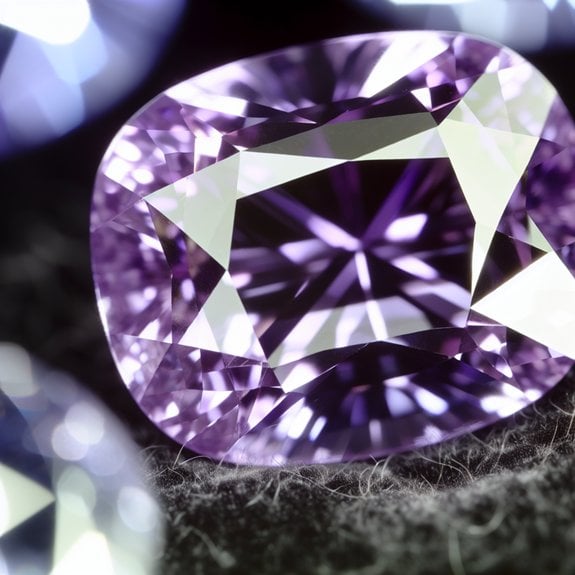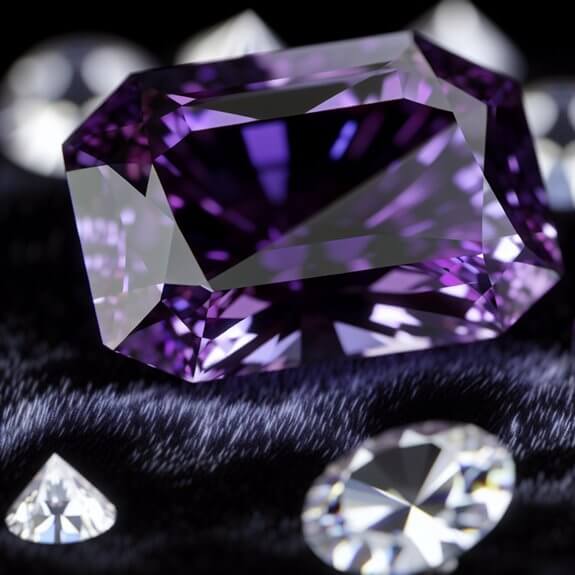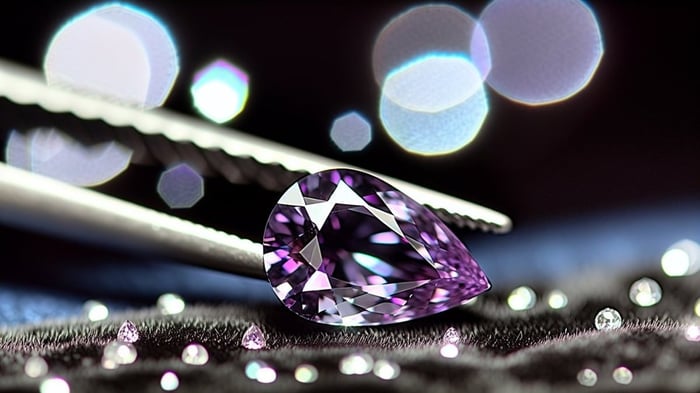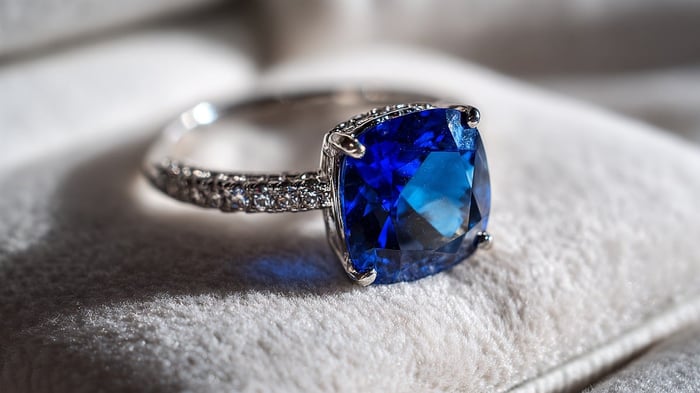Table of Contents
- Key Takeaways About Purple Diamonds
- Purple: The Colour of Rarity
- What Makes a Diamond Purple
- Rarity and Market Value
- Treated Purple Diamonds – Beauty by Design
- Natural vs Treated: How to Tell the Difference
- Investing or Buying for Beauty
- Purple – The Colour of Impossibility
- Love Colour? Explore All Diamond’s Coloured Gemstones
- FAQs
Key Takeaways About Purple Diamonds
- Purple diamonds are among the rarest hues, with unmodified purples comprising just 0.05% of all studied diamonds.
- Their colour arises from crystal lattice distortions and trace elements such as hydrogen and boron under immense geological pressure.
- Most weigh under 1.5 carats; larger stones command substantial premiums.
- Pure, intense purple tones are most valuable, while grey or brown modifiers reduce worth.
- Since the Argyle mine’s closure, supply has tightened and prices have surged, top stones exceed £230,000 per carat.
Purple: The Colour of Rarity
Although diamonds appear in every imaginable hue, purple remains one of the rarest and least understood. Natural purple diamonds are so scarce that even experienced jewellers may never handle one in their careers. Most discoveries trace back to Australia’s Argyle mine, with smaller finds emerging from Siberia, Canada, and Brazil. Their limited availability keeps public awareness low, even within the trade, while scarcity fuels a quiet demand among collectors seeking distinction from convention.
Market value rises with stronger, purer hues; secondary pink enhances appeal, whereas grey or brown dulls it. Historically, purple has signified royalty, influence, and creativity, long associated with emperors, bishops, and artists. The connection between rarity and prestige has endured for centuries, from the Tyrian purple dyes of antiquity to the limited purple diamonds that now capture modern fascination. Notable gems, such as the Royal Purple Heart, a cushion-cut stone of over seven carats, add to the mystique; their owners and final prices remain shrouded in secrecy.
A purple diamond is the product of impossibly precise pressure, chemistry, and time, beauty born of distortion.
As the supply narrows, purple diamonds have come to symbolise both the freedom to choose rarity and the human instinct to find beauty in imperfection.
What Makes a Diamond Purple
A diamond turns purple when its rigid crystal lattice is subtly distorted deep underground, altering how it absorbs and reflects light. Trace elements, particularly hydrogen and occasionally boron, influence the outcome, producing tones from lilac to deep violet. Together, these structural stresses and impurities dictate intensity, from faint lavender to vivid royal purple.
Crystal Lattice Distortions
When carbon atoms are squeezed and shifted by tectonic stress, the lattice develops microscopic misalignments that selectively absorb light. These distortions, sometimes called “plastic deformation”, change the stone’s optical behaviour, filtering specific wavelengths and leaving behind the elusive purple hue. Stronger lattice strain tends to yield more vivid, saturated colour, a rare and coveted result.
Such geological violence explains why purple diamonds often occur in the same deposits as pinks: both result from deformation rather than elemental substitution. Yet purple’s atomic pathways are even narrower, requiring precise stress orientations rarely achieved in nature. That rarity makes every naturally purple stone something of a geological miracle.

Trace Elements and Colour Influence
Hydrogen can produce lavender to rich purple tones, while boron, the same impurity responsible for blue diamonds, can deepen or shift the hue towards violet under intense pressure. These trace atoms subtly alter the diamond’s electronic band structure, changing how it interacts with light.
The combination of deformation and elemental presence determines the final colour balance. Hydrogen alone may yield soft, pastel lilac, while boron contributes a colder, violet edge. When both forces align, the result is the saturated “royal purple” that commands global attention.
Sapphire & Diamond Tennis Bracelet 2.25ct in 18k White Gold

£1,997.00
£3,557.00
Handcrafted elegance overflows in this stylish sapphire and diamond tennis bracelet. 1.05 carats of sparkling and ethically sourced diamonds are set alongside bright and gleaming sapphires in a rub-over bezel setting on brilliant 18k white gold, which is sure to… read more
Rarity and Market Value
Unmodified purple diamonds represent just 0.05% of over 90,000 GIA-studied stones. Most weigh under 1.5 carats, and their scarcity intensifies dramatically with size. The closure of the Argyle mine in 2020 further constricted global supply, leaving only sporadic production in Russia, South Africa, and Canada. Even among fancy-colour specialists, a 2-carat vivid purple can become the highlight of a lifetime’s inventory.
Rarity and Value by Grade
| Colour Grade | Typical Carat Range | Indicative Price per Carat (GBP) | Notes |
|---|---|---|---|
| Fancy Light Purple | 0.5–1.0 ct | £10,000–£20,000 | Soft lavender hues, low saturation |
| Fancy Intense Purple | 0.5–2.0 ct | £120,000–£270,000 | Rich violet, strong saturation |
| Fancy Vivid Purple | 1.0–2.0 ct | £250,000–£350,000 | Pure, bright purple, extremely rare |
| Fancy Purplish Pink | 0.5–1.5 ct | £30,000–£80,000 | Popular hybrid, softer market entry |
| Fancy Vivid Purple-Pink (Auction Grade) | 1.0+ ct | £1M+ | Record-setting rarity, museum level |
Colour intensity and purity drive price far more than clarity or cut, although symmetry and polish enhance brilliance. Provenance adds further premiums, particularly for Argyle or Siberian stones.
Treated Purple Diamonds – Beauty by Design
While nature’s purples are vanishingly rare, modern science has found ways to reproduce their allure. Treated purple diamonds owe their colour to engineered enhancement processes such as irradiation, HPHT (High Pressure High Temperature), or thin-film coatings. These methods can create vivid, stable hues at accessible prices, but full disclosure and careful maintenance are essential.
In the secondary market, treated stones occupy a distinct category: admired for their appearance, not for their pedigree. Collectors appreciate transparency, while fashion buyers embrace the freedom to wear striking colours without six-figure price tags.
Common Colour-Enhancement Methods
| Treatment | Process Summary | Resulting Hue / Stability | Care Notes |
|---|---|---|---|
| Irradiation + Annealing | Electron bombardment then heat to adjust colour centres | Violet-purple; stable/permanent | Normal wear; disclosure required |
| HPHT | Extreme pressure/temperature reconfigures lattice defects | Deep purple/violet; durable | Stable colour; safe for setting |
| Thin-Film Coating | Surface film adds violet cast | Temporary; may abrade/fade | Avoid abrasives/ultrasonic |
| Fracture Filling | Resin fills feathers; can warm tone | Heat sensitive; may flash | No soldering/polishing without specialist |
The ethics of enhancement hinge on disclosure. GIA does not grade fracture-filled diamonds, whereas some European labs may issue clarity-enhanced reports with annotations. Ethical jewellers always disclose treatments; doing otherwise risks reputation as much as resale value.
Oval Pink Sapphire & Diamond 1.88ct Halo Ring in 18k Rose Gold

£1,908.00
£3,387.00
This remarkably feminine ring is handcrafted in romantic 18k rose gold and features a beautiful oval-cut pink sapphire stone mounted in a four claw setting. The 1.52ct pink stone is surrounded by a halo of round-cut diamonds with more diamonds… read more
Natural vs Treated: How to Tell the Difference
Under magnification, natural purple diamonds reveal irregular, lattice-driven colour zoning, often following crystal growth lines. Treated stones, by contrast, display uniform or sharply banded patterns aligned with irradiation or HPHT processes.
- Gentle, patchy zoning following growth lines → natural origin
- Sharp, linear bands or halos near facets → treated
- Surface-only colour → coated stone
- Consistent hue across lighting → typically natural stability
Laboratory spectroscopy confirms origin by analysing absorption peaks and defect signatures. In short: nature paints with pressure; technology paints with precision.

Investing or Buying for Beauty
True purple diamonds occupy a rarefied niche where investment meets emotion. Fewer than 100 carats of fine natural purple stones are estimated to exist globally. Most weigh under two carats, making size secondary to colour quality and provenance.
Long-Term Value Factors
- Pure purples and Argyle-sourced stones lead appreciation potential.
- Pinkish modifiers can enhance demand; grey or brown reduce it.
- Clean clarity and balanced faceting preserve liquidity.
- Matched pairs are exceptionally rare, single stones dominate.
- Limited historical supply supports price resilience over decades.
Aesthetic Priorities
For those buying primarily for beauty, colour is everything. A strong hue with lively brilliance will always outshine a larger but duller stone. Platinum or white-gold settings emphasise violet tones, while rose gold flatters pink-purple blends. Because purple diamonds are tough but not indestructible, mountings should protect edges and corners.
Designers frequently pair them with white diamonds or pink sapphires to heighten contrast and reinforce the sense of rarity. Synthetics or treated stones can echo the look at a fraction of the cost, proof that admiration for purple’s magic needn’t be limited to collectors.
Halo Tanzanite 1.55ct & 0.35ct G/SI Diamond Necklace in 18k White Gold

£1,185.00
£1,957.00
A striking halo of hand-cut, ethically sourced diamonds encircle a carat and a half of exotic tanzanite and accentuate its deep blue beauty. This necklace will be a delightful addition to your loved one's collection and a versatile and much-used… read more
Purple – The Colour of Impossibility
Behind the dreamlike glow of a purple diamond lies exact science, pressure, chemistry, and atomic imperfection. Their hue is not fantasy but the visible trace of geological trauma, crystallised over eons.
Scarcity, symbolism, and physics converge to make purple diamonds a paradox: the product of imperfection, perfected by time. They invite fascination not because they are flawless, but because they reveal how beauty can emerge from distortion.
For collectors, they represent freedom from the ordinary. For wearers, they embody individuality shaped by the most unlikely of forces.
A purple diamond is more than a gem; it’s a fragment of the impossible, proof that under extreme pressure, even carbon learns to dream in colour.
FAQs
How Should Purple Diamonds Be Insured and Appraised for Replacement Value?
Collectors secure replacement value through certified gemmological reports, detailed photos, and comparables. Insurance policies should have a set value, be valid worldwide, and list specific items, with yearly updates, safe storage options, and rules to prevent loss, allowing for flexible coverage during travel and
Do Purple Diamonds Require Special Care or Storage Conditions?
Yes. Purple diamonds benefit from cool, dry storage conditions, separate from abrasive stones, with secure pouches. Cleaning methods should avoid harsh chemicals and ultrasonic machines; instead, gentle soap, lukewarm water, and soft brushes preserve colour, polish, and mounting integrity.Yes. Purple diamonds benefit from cool, dry storage conditions, separate from abrasive stones, with secure pouches. Cleaning methods should avoid harsh chemicals and ultrasonic machines; instead, gentle soap, lukewarm water, and soft brushes preserve colour, polish, and mounting integrity.
Are Lab-Grown Purple Diamonds Ethically Different from Natural Ones?
Straight off the bat, yes, lab-grown purple diamonds differ ethically. They typically guarantee ethical sourcing with minimal environmental impact, though questions about diamond authenticity persist. Natural stones carry mining concerns and scarcity-driven value, appealing to autonomy seekers valuing individuality and transparency.
Which Settings Best Enhance the Colour of Purple Diamonds?
Bezel or halo settings with violet or pink accent stones amplify saturation. Metal choice matters: rose or yellow gold boosts warmth; platinum offers stark colour contrast. Closed pavé backs and minimal prongs intensify hue, empowering expressive, individualised design freedom.
How Do Purple Diamonds Perform Under Different Lighting Environments?
They bloom under daylight, yet shift like twilight moods across environments. Colour perception intensifies under cool LEDs, softens in warm incandescent glow; lighting effects sculpt saturation, scattering fire. Freedom‑seekers favour adaptable settings, letting each scene script the stone’s radiant narrative.




